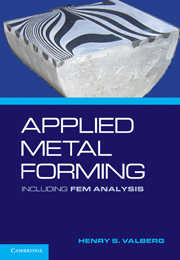Book contents
- Frontmatter
- Contents
- Preface
- APPLIED METAL FORMING
- 1 Characteristics of Metal Forming
- 2 Important Metal Forming Processes
- 3 FEA of Metal Forming
- 4 Theory
- 5 Reduction and Proportions of the Plastic Zone
- 6 Deformations from the Velocity Field
- 7 Technological Tests and Physical Simulation
- 8 Flow Stress Data
- 9 Formability and Workability
- 10 Friction and Friction Models
- 11 Thermal Effects
- 12 Experimental Metal Flow Analysis
- 13 Theoretical Methods of Analysis
- 14 Finite Element Analysis
- 15 FEA of Technological Tests
- 16 Forging
- 17 FEA of Forging
- 18 Extrusion
- 19 FEA of Extrusion
- 20 Rolling
- 21 FEA of Rolling
- 22 Drawing of Wire, Profiles, and Tubes
- 23 FEA of Wiredrawing
- 24 Sheet-Metal Forming
- Index
- References
16 - Forging
Published online by Cambridge University Press: 05 June 2012
- Frontmatter
- Contents
- Preface
- APPLIED METAL FORMING
- 1 Characteristics of Metal Forming
- 2 Important Metal Forming Processes
- 3 FEA of Metal Forming
- 4 Theory
- 5 Reduction and Proportions of the Plastic Zone
- 6 Deformations from the Velocity Field
- 7 Technological Tests and Physical Simulation
- 8 Flow Stress Data
- 9 Formability and Workability
- 10 Friction and Friction Models
- 11 Thermal Effects
- 12 Experimental Metal Flow Analysis
- 13 Theoretical Methods of Analysis
- 14 Finite Element Analysis
- 15 FEA of Technological Tests
- 16 Forging
- 17 FEA of Forging
- 18 Extrusion
- 19 FEA of Extrusion
- 20 Rolling
- 21 FEA of Rolling
- 22 Drawing of Wire, Profiles, and Tubes
- 23 FEA of Wiredrawing
- 24 Sheet-Metal Forming
- Index
- References
Summary
The classification system for metal forming processes shown in Fig. 2.1 partitions the forging processes into three different groups: open-die forging, closed-die forging, and impact extrusion. In reality, open-die forging consists of a number of different subprocesses, in each of which considerable parts of the workpiece are formed freely, without full contact with the dies; see, for instance, cogging, as shown in Fig. 2.2(c). Closed-die forging, on the other hand, refers to forging between dies, where at the end of forging, either the entire workpiece is confined in a closed space between the dies, or an amount of excess material is used, which flows out of the flash gap; see Fig. 2.3(b). When flash is formed, the process is most commonly called closed-die forging. When there is no flash, the process is called precision forging, flashless forging, or zero-loss forging. Impact extrusion, such as forward and backward cup extrusion, is also described in Ch. 2; see Fig. 2.4. Both are commonly classified as forging processes. In addition, many more exotic forging processes have been developed over the years.
In this chapter, some practical aspects of importance in closed-die forging processes will be considered. First, the concept of forgeability will be discussed. Then the implications of this concept for forging practice will be dealt with, such as selection of forging temperature and possible shapes of forgings. A common classification system for forged components will also be presented. After this, commonly used design principles in multistep forging processes will be discussed.
- Type
- Chapter
- Information
- Applied Metal FormingIncluding FEM Analysis, pp. 268 - 284Publisher: Cambridge University PressPrint publication year: 2010



